![]()
![]()
![]()
Use LEFT and RIGHT arrow keys to navigate between flashcards;
Use UP and DOWN arrow keys to flip the card;
H to show hint;
A reads text to speech;
6 Cards in this Set
- Front
- Back
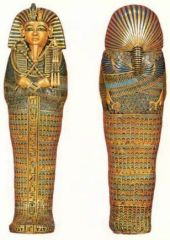
Coffin of Tutankhamun Egyptian
|
King Tutankhamun died at age 19 after ruling for 10 years. When they recovered his tomb, they discovered the large amount of artifacts and treasures along with him to accompany him to the afterlife. He was the son of Akhenaten. He changed many practices that his father put forth. The story is that Tutankhamun was assassinated due to the hole in his scull. |
|
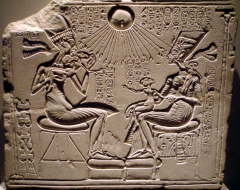
Relied of Akhenaten, Nefertiti et.al Egyptian
|
The relief sculpture showed a sunken in technique. It is said that Akhenaten had six daughters and had sexual consorts with them so he got a son heir. It's said because the sculptures of the family are shapes differently and distorted so that could be a product of sexual consorts in the family. |
|
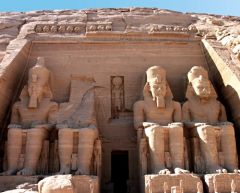
Temple of Ramses II at Abu Simbel Egyptian
|
Egyptian pharaoh. Also known as Sesostris. It is said that he had over 200 children. Sculpture is on the west side of the river(for the dead.) They wanted it to face the rising sun. 3 chambers. The first one had pillars of ramses that helped hold it up. (Twice a year the sun reaches the inner samctum. February 22 & October 22) |
|
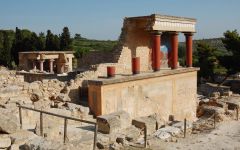
Palace of Knossos Minoan c.1700-1400 BC
|
Was revered to as the "House of the Double Axes" because double-axe motifs were used in decoration. It had a complicated layout and a security system. It's a result of earthquakes and rebuilding over time. 150,00 square feet. No one knows exactly how it was destroyed. |
|
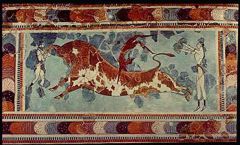
Bull Leapers Minoan
|
A young man performing what appears to be a handspring or flip over a charging bull. Two young women flank the bull. (We know the sexes of the stylized figures by the way they are painted—women’s skin is usually much lighter than men’s in ancient Greek art.) Many people say this painting is strictly decorative, but others say it represents a historical event. |
|
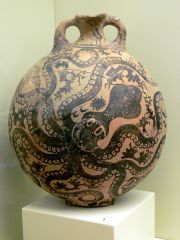
Octopus Vase Minoan
|
Was named after King Minos of Crete. It gives the impression that a living octopus finds its home on Minoan vases. The movement and smoothness of the octopus on the vase shows no hesitation and promotes free expression. Shows respect to each individuals lives. |

